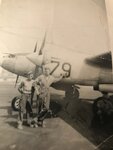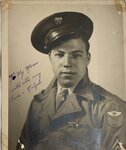Navigation
Install the app
How to install the app on iOS
Follow along with the video below to see how to install our site as a web app on your home screen.
Note: This feature may not be available in some browsers.
More options
You are using an out of date browser. It may not display this or other websites correctly.
You should upgrade or use an alternative browser.
You should upgrade or use an alternative browser.
P38?
- Thread starter Babs3292
- Start date
Ad: This forum contains affiliate links to products on Amazon and eBay. More information in Terms and rules
More options
Who Replied?fubar57
General
Correct about the P-38, 79 is the aircraft number, to identify the aircraft in a squadron or group. Any ideas about the photo itself?
- Thread starter
- #3
I know very little. I do know that my relative in the photo was assigned to the 4th AF, but I do not know what wing or squadron he was assigned to. He enlisted in 1943, discharged in 1946. I know the 4th was (still is) hq on the west coast. I believe he was aircraft maintainer. He spent some time in CA and TX to my understanding.Correct about the P-38, 79 is the aircraft number, to identify the aircraft in a squadron or group. Any ideas about the photo itself?
I believe you are correct about the P-38 belonging to the 4th AF.
Perhaps this link may help you
Pacific Northwest Lightning: Portland's P-38 Lightning Flying Training Program of 1944 - 1945 > 142nd Fighter Wing > Display
Eagledad
Perhaps this link may help you
Pacific Northwest Lightning: Portland's P-38 Lightning Flying Training Program of 1944 - 1945 > 142nd Fighter Wing > Display
Eagledad
- Thread starter
- #5
Thanks Eagledad! This may prove super helpful. The only other bit I know is that my relative was at Camp Ono near San Bernadino at some point.I believe you are correct about the P-38 belonging to the 4th AF.
Perhaps this link may help you
Pacific Northwest Lightning: Portland's P-38 Lightning Flying Training Program of 1944 - 1945 > 142nd Fighter Wing > Display
Eagledad
I know Wikipedia is not the end all for information. However, I have generally found it to be quite accurate as many pages are maintained by people directly involved with the subject. Here is a link:
142nd Fighter Wing - Wikipedia
No where on the page of the 142nd Fighter Wing do they show P-38s as a part of the aircraft complement. Originally, the 142nd was identified as the 371st Fighter Group on 25 May 1943. It was de-activated in Nov 1945 and then re-designated as the 142nd. During WWII it appears they only used P-47Ds followed post war with P-51Ds.
142nd Fighter Wing - Wikipedia
No where on the page of the 142nd Fighter Wing do they show P-38s as a part of the aircraft complement. Originally, the 142nd was identified as the 371st Fighter Group on 25 May 1943. It was de-activated in Nov 1945 and then re-designated as the 142nd. During WWII it appears they only used P-47Ds followed post war with P-51Ds.
fubar57
General
I know Wikipedia is not the end all for information. However, I have generally found it to be quite accurate as many pages are maintained by people directly involved with the subject. Here is a link:
142nd Fighter Wing - Wikipedia
No where on the page of the 142nd Fighter Wing do they show P-38s as a part of the aircraft complement. Originally, the 142nd was identified as the 371st Fighter Group on 25 May 1943. It was de-activated in Nov 1945 and then re-designated as the 142nd. During WWII it appears they only used P-47Ds followed post war with P-51Ds.
The 142nd Fighter Wing, in its humble beginnings, flew the Lockheed F-6E
Primary Aircraft Assigned of the 142nd Fighter Wing, 1941 to Present > 142nd Fighter Wing > Display
GreenKnight121
Senior Airman
- 734
- Mar 16, 2014
The photo shows a P-38J or P-38L (has guns & deep chin intakes, lacks the under-nose radar pod of the P-38M).
F-5E was the unarmed photo-recon version converted from the P-38J and P-38L, 705 built.
The F-6 in WW2 was a photo-recon version of the P-51.
F-4 & F-5 were the photo-Lightnings (P-38G/H & J/L respectively). They had no guns, and cameras in the nose, as below.
F-4:

F-5:

F-5E was the unarmed photo-recon version converted from the P-38J and P-38L, 705 built.
The F-6 in WW2 was a photo-recon version of the P-51.
F-4 & F-5 were the photo-Lightnings (P-38G/H & J/L respectively). They had no guns, and cameras in the nose, as below.
F-4:
F-5:
ODonovan
Airman 1st Class
Camp Ono also looks to be a dead end. They worked on tanks, but not aircraft.
Camp Ono
There was the Los Angeles Fighter Wing, which would have been closest to San Bernardino. They had the following fighter groups attached in late '43 into '44.
329th
360th
364th
412th
473rd
474th
479th
I don't have time, at the moment, to check all those out. However, I doubt there was much difference in markings, between the groups. Having the individual aircraft numbers on the nose was common practice. Having them on the nacelles was pretty rare. I found this picture of one, but Joe Baugher's page has nothing on the S/N other than where the AC was written off. If the AC in your photo is from a training unit, it wouldn't be unusual for them to have both bare metal and painted 38s in their inventory, so that probably won't be any help, either.

Best of luck!
-Irish
Camp Ono
There was the Los Angeles Fighter Wing, which would have been closest to San Bernardino. They had the following fighter groups attached in late '43 into '44.
329th
360th
364th
412th
473rd
474th
479th
I don't have time, at the moment, to check all those out. However, I doubt there was much difference in markings, between the groups. Having the individual aircraft numbers on the nose was common practice. Having them on the nacelles was pretty rare. I found this picture of one, but Joe Baugher's page has nothing on the S/N other than where the AC was written off. If the AC in your photo is from a training unit, it wouldn't be unusual for them to have both bare metal and painted 38s in their inventory, so that probably won't be any help, either.
Best of luck!
-Irish
Barrett
Senior Airman
Sidebar: the 412th FG was (probably) the only one that flew the Bell P-59 jet. The two members I knew were Tex Hill and Rex Barber, and they would've been happier in 51s or 38s!
- Thread starter
- #11
Camp Ono also looks to be a dead end. They worked on tanks, but not aircraft.
Camp Ono
There was the Los Angeles Fighter Wing, which would have been closest to San Bernardino. They had the following fighter groups attached in late '43 into '44.
329th
360th
364th
412th
473rd
474th
479th
I don't have time, at the moment, to check all those out. However, I doubt there was much difference in markings, between the groups. Having the individual aircraft numbers on the nose was common practice. Having them on the nacelles was pretty rare. I found this picture of one, but Joe Baugher's page has nothing on the S/N other than where the AC was written off. If the AC in your photo is from a training unit, it wouldn't be unusual for them to have both bare metal and painted 38s in their inventory, so that probably won't be any help, either.
View attachment 570651
Best of luck!
Thanks!! This gets me a little closer, and good resources to check on!
-Irish
- Thread starter
- #12
As I continue to dig into this, the author of this thread noted his relative served in the Fourth Air Force. The only relevant Fighter Group I can find which was assigned to the Fourth Air Force was the 473rd which was operating out of Los Angeles in late 1943. This unit did in fact fly P-38s (again, I refer to Wikipedia) and was a replacement training unit. I am not sure of the validity to the reference of 142nd Fighter Wing other than it was on the west coast around Portland.Camp Ono also looks to be a dead end. They worked on tanks, but not aircraft.
Camp Ono
There was the Los Angeles Fighter Wing, which would have been closest to San Bernardino. They had the following fighter groups attached in late '43 into '44.
329th
360th
364th
412th
473rd
474th
479th
I don't have time, at the moment, to check all those out. However, I doubt there was much difference in markings, between the groups. Having the individual aircraft numbers on the nose was common practice. Having them on the nacelles was pretty rare. I found this picture of one, but Joe Baugher's page has nothing on the S/N other than where the AC was written off. If the AC in your photo is from a training unit, it wouldn't be unusual for them to have both bare metal and painted 38s in their inventory, so that probably won't be any help, either.
View attachment 570651
Best of luck!
-Irish
Last edited:
Users who are viewing this thread
Total: 1 (members: 0, guests: 1)


